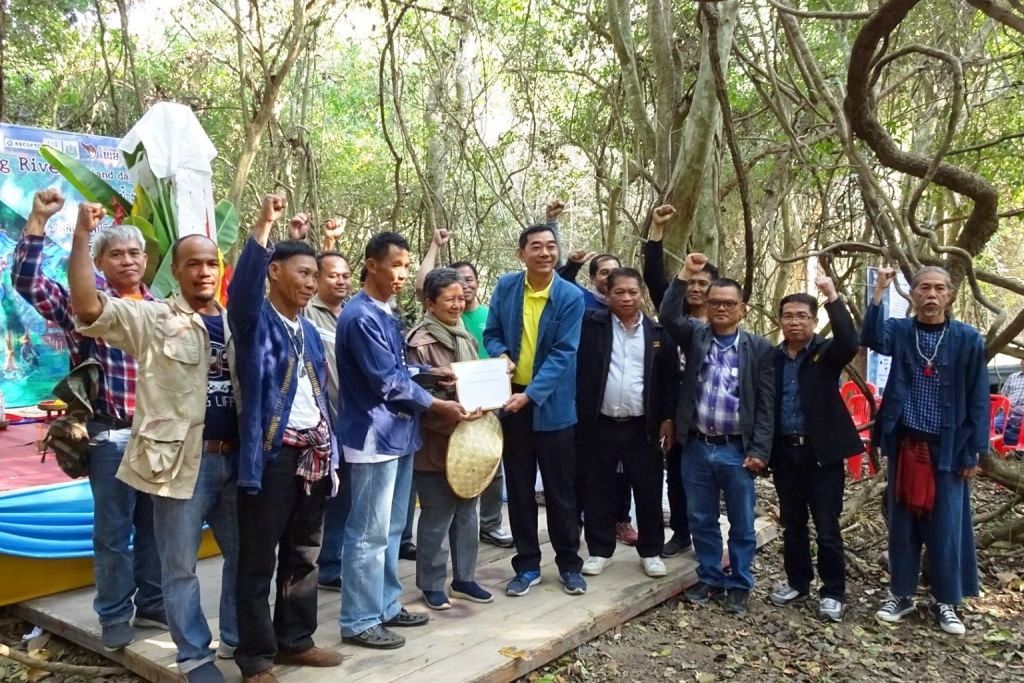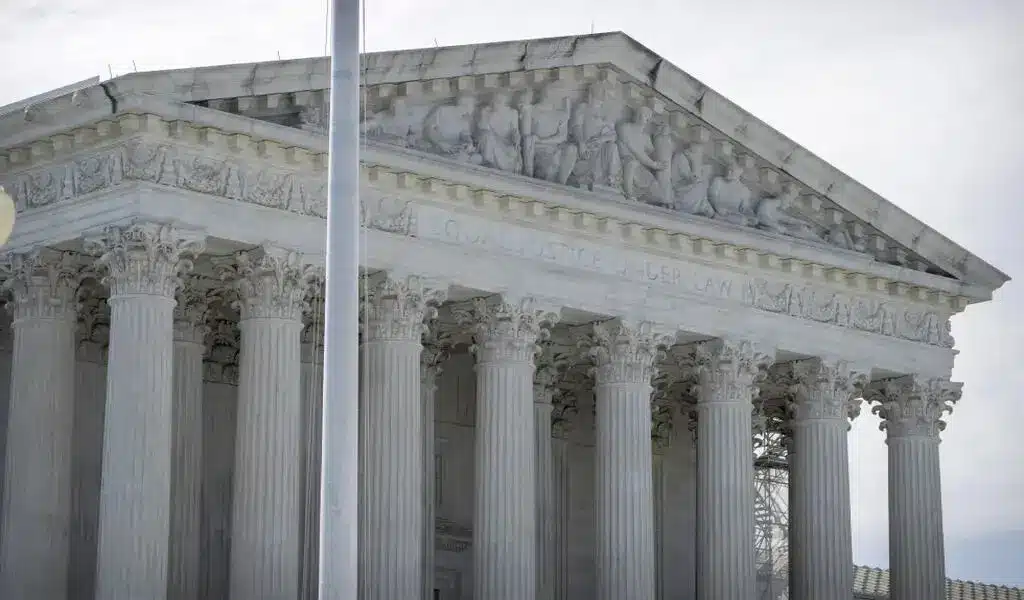News
Chiang Rai Community Continues the Fight to Save its Wetland Forest
“Community members in Ban Boon Rueang, in Thailand’s northern Chiang Rai province, successfully campaigned against plans to convert a wetland forest into a special economic zone”

Srongpol Chantharueang remembers his parents telling him as a boy always to protect the local wetland forest when he grew up. They told him that the ecosystem would be important for his life and that of his community. “I didn’t understand what they meant at the time,” he told Mongabay via a video call. “I didn’t understand what the true value of the wetland forest was.”
Srongpol chairs the Boon Rueang Wetland Forest Conservation Group, which partnered with international nonprofits, civil society organizations and local academic institutions to share evidence of the importance of the wetland forest for biodiversity and the local community
A village leader, Srongpol lives in Ban Boon Rueang, a town in Thailand’s northern Chiang Rai province. Nestled between the Doi Yao mountain range and the lower reaches of the Ing River, a 260-kilometer (160-mile) tributary of the Mekong, Ban Boon Rueang is an unassuming town with an agrarian lifestyle that goes back generations. But in recent years, community members have been roused to take action to protect the surrounding nature that provides them with sustenance and secures spiritual connections to their ancestors.
The community averted tragedy in 2015 when the Thai central government declared the local wetland forest — a 483-hectare (1,200-acre) haven of biodiversity — a target for the development of a special economic zone (SEZ), as part of a nationwide strategy to expand infrastructure and attract foreign investment.
Mobilize to protect the land
Thailand has experienced rapid economic development, accompanied by population growth, urbanization and natural resource depletion, over recent decades. Between 1961 and 1998, Thailand’s forest cover decreased from 53% to 25% of the nation’s total area, representing a loss of 14.4 million hectares (35.6 million acres) of forest. Wetlands have been over exploited, cleared for agriculture, or filled in for the development of residential and industrial estates.
Village inhabitants foresaw what the SEZ would mean for their treasured ecosystem: the wetland would be filled in with concrete and the trees cut down.
Their response was to mobilize to protect the land, which they have customarily managed for more than 200 years. The campaign successfully convinced authorities that the wetland forest was more beneficial economically and socially in its natural state. In 2018, the Chiang Rai provincial government withdrew the proposal to use the site as an SEZ — a great victory for Ban Boon Rueang and for Srongpol.
The community’s quiet and methodical revolution recently gained international recognition: they were awarded the 2020 Equator Prize by the United Nations Development Program.
“By asserting their rights to manage the wetland forest, the community members protect their rights, identity and their future,” said Warangkana Rattanarat, Thailand country director of RECOFTC, a nonprofit international organization that worked alongside the community to protect and sustainably manage the forest. “Their success is an inspiration to other communities who are fighting similar injustices and threats.”
However, while the villagers successfully fought off the development proposal, they continue to grapple with such threats as climate change and upstream dams, which harm the integrity of the ecosystem by preventing vital seasonal flooding of the wetland forest.

An important ecosystem
Boon Rueang wetland forest is the largest in a network of 26 wetland forests that swathe the meandering lower Ing River, en route to its confluence with the Mekong River at the Thai-Lao border. It is credited with saving the village from the devastating floods that swept the region in 2010. Although neighboring villages were engulfed, Boon Rueang was comparatively unscathed owing to the capacity of the wetland to buffer the floodwaters.
To the village residents, the wetland forest is a lifeline, providing clean water, fish spawning and nursery grounds, and a riparian ecosystem on which the community depends. “It is like a village kitchen,” Srongpol said. “Its charm lies in its seasonality. Every season there is something different that we can gather to eat.” According to RECOFTC, the annual cost of replacing the lost livelihoods and ecosystem services provided by the wetland forest would be an estimated $4 million.
Srongpol chairs the Boon Rueang Wetland Forest Conservation Group (BRWFCG), which serves as the community’s governing body for its wetland forest. When faced with the SEZ development, the BRWFCG spearheaded the community’s resistance, engaging a broad range of stakeholders to help gather information about the wetland forest’s importance.
Data compiled by the BRWFCG and its partners revealed that the riparian ecosystem supports at least 276 species, including 87 types of fish and several dozen edible plants. Recent camera trapping and DNA studies confirmed the presence of leopard cats (Prionailurus bengalensis) and near-threatened Eurasian otters (Lutra lutra). There are anecdotal reports of other species on the IUCN Red List, such as critically endangered Sunda pangolins (Manis javanica), vulnerable fishing cats (Prionailurus viverrinus), and near-threatened king cobras (Ophiophagus hannah).
Loss of many wetlands
According to the 2020 WWF Living Planet Report, nearly 70% of global wetlands have been lost since 1900 and they are still being destroyed three times faster than forests. In Thailand, pressure to convert land for agriculture, aquaculture and industry has resulted in the loss of many wetlands, which accounted for 7.5% of the nation’s land area in 1999.
Lowland wetland forests, like Boon Rueang, are an increasingly rare lowland ecosystem in the region, which have tremendous carbon storage potential — double the capacity of a mixed deciduous forest, according to RECOFTC.
Despite the pivotal role of wetlands in countering climate change, supporting biodiversity and mitigating disaster risk, the 2018 Global Wetland Outlook, published by the Ramsar Convention on Wetlands, found that wetlands remain “dangerously undervalued” by policy- and decision-makers in national plans.
The community action of the Boon Rueang residents is a rare beacon of hope for wetlands. “By conserving the wetland forest, the community helps protect biodiversity in the region while also mitigating climate change,” said Warangkana of RECOFTC.

Rivers out of balance
Nonetheless, climate change remains a pervasive threat. The region has been rocked by severe El Niño-driven droughts over the last few years. When combined with the changing flow regimes on the mainstream Mekong River due to upstream dams beyond the villagers’ jurisdiction, not even the most targeted community action can avert the consequences.
The flooding patterns that sustain the Ing River and its wetlands are determined by the natural flow cycle in the roughly 2,050-km (1,270-mi) stretch of the upper Mekong River, from where it rises in the Tibetan plateau to its confluence with the Ing River in Thailand.
During the wet season, which typically runs from August to November, the Mekong River transitions into a flood phase, which sends a surge of floodwater up the lower Ing River. This flood pulse nourishes waterways and lakes in the wetland forests and carries migratory fish from the Mekong into the Ing River, where they support the livelihoods and diets of local fishing communities.
Despite the importance of the upper Mekong’s natural flow regime to downstream habitats and communities, Chinese firms have so far built 11 hydropower dams on the mainstream river within China’s borders, with more completed or under construction in neighboring Laos.
Studies implicate the upstream dams in weakened flood patterns in downstream catchments over recent years. A 2020 report by researchers from Eyes on Earth, a U.S. environmental research group, suggests that Chinese dams regulating water flow during the wet season in 2019 exacerbated the effects of climate-driven El Niño droughts for communities downstream.
Dwindling water levels
The upstream Mekong’s weakened flood pulse sets off “a domino effect throughout the ecosystem,” according to Teerapong Pomun, director of the Thai NGOs Living Rivers Association and the Mekong Community Institute, which work with communities along the Ing River to manage their wetland forests.
Dwindling water levels and the weakened Mekong flood pulse due to the combination of dams and El Niño-driven dry spells are a serious concern here. “Villagers report that the Mekong River no longer fluctuates according to seasonal flood patterns, meaning that the river levels are abnormally low and fish replenishment has decreased,” said Warangkana of RECOFTC.
In Boon Rueang, Srongpol mentions how it was once necessary to move about the wetland forest by boat during the wet season. “For the past few years, it has been possible to walk on foot year-round,” he said.
Thai civil society organizations have been campaigning against development schemes in the Mekong River for more than two decades. “We try to raise the issue among local people and petition decision-makers in China, but it is very hard to have our voices heard,” Teerapong said.
The recent inauguration of the Mekong People’s Forum, comprising civic groups from eight Thai provinces that border the Mekong, helps to address such issues at the policy level. “We need to unite our voices,” Teerapong said. “The dams are not just a problem for people living along the mainstream Mekong; this is a problem for communities along the tributaries too.”

Conservation and international protection
Through BRWFCG, the Boon Rueang community has an active voice in such regional advocacy platforms and continues its drive to sustain a healthy wetland forest. Its approach has inspired nearby villages to take similar action to stand up against the pervasive threat of land grabbing.
By following customary management approaches that focus on living in balance with nature, the community has mitigated some impacts. Sixty-three communities along the Ing River have established fish conservation zones, where fishing activity is restricted to protect vulnerable spawning habitats. These fish conservation zones are steeped in Buddhist traditions: the waters are blessed by a local monk and, thus, respected. Studies by Living Rivers Association have found that fish size and numbers increase in these zones. The BRWFCG is also cultivating a plant nursery and organic fertilizer system to restore the wetland forest and its soil quality.
Due to the community’s efforts, the immediate threat from SEZ development has abated. However, there is still no guarantee that developers will not target the area again in the future. Over the years, the community has repeatedly fought off attempts to convert the wetland for other purposes, such as for factories and plantations.
“When the SEZ proposal was withdrawn, we asked the governor to guarantee that nobody would touch the land,” said village leader Srongpol. “But the governor said when he retires there is no guarantee that the next administration will not want to develop on it.”

Protection under international law
The community does not formally own the wetland forest land. In 1967, a Public Land Certification granted the community legal rights to fish, graze buffalo and establish a community forest from which they can gather non-timber forest products. Agreements that govern such activities “are not enough to protect them legally,” according to Teerapong.
For this reason, the community is working with partners to designate the wetland forest landscape of the lower Ing River, including the Boon Rueang wetland forest, for global protection as a Wetland of International Importance under the Ramsar Convention.
Although Thailand has 15 sites designated under the Ramsar Convention, totaling more than 400,000 hectares (990,000 acres) of wetlands, the habitats of the Ing River watershed are not among them.
Advocates say they hope that such protection under international law will safeguard the important wetland forest ecosystems from future development pressure.
The Ramsar bid has the endorsement of several villages and the Chiang Rai provincial leader. However, outreach and dialogue continue with communities throughout the river basin to ensure their inclusivity in the proposal. Teerapong estimates the proposal will be ready within the next two years.
For Srongpol Chantharueang, the simple sight of water buffalo grazing in the wetland sparks joy. They have been a constant in the wetland forest landscape since his boyhood. He knows his community cannot afford to get complacent. “To destroy the forest is very easy,” he said. “To protect it and improve it for nature and the local people is much more challenging.”
Source: Monogabay

News
Trudeau’s Gun Grab Could Cost Taxpayers a Whopping $7 Billion

A recent report indicates that since Trudeau’s announcement of his gun buyback program four years ago, almost none of the banned firearms have been surrendered.
The federal government plans to purchase 2,063 firearm models from retailers following the enactment of Bill C-21, which amends various Acts and introduces certain consequential changes related to firearms. It was granted royal assent on December 15 of last year.
This ban immediately criminalized the actions of federally-licensed firearms owners regarding the purchase, sale, transportation, importation, exportation, or use of hundreds of thousands of rifles and shotguns that were previously legal.
The gun ban focused on what it termed ‘assault-style weapons,’ which are, in reality, traditional semi-automatic rifles and shotguns that have enjoyed popularity among hunters and sport shooters for over a century.
In May 2020, the federal government enacted an Order-in-Council that prohibited 1,500 types of “assault-style” firearms and outlined specific components of the newly banned firearms. Property owners must adhere to the law by October 2023.
Trudeau’s Buyback Hasn’t Happened
“In the announcement regarding the ban, the prime minister stated that the government would seize the prohibited firearms, assuring that their lawful owners would be ‘grandfathered’ or compensated fairly.” “That hasn’t happened,” criminologist Gary Mauser told Rebel News.
Mauser projected expenses ranging from $2.6 billion to $6.7 billion. The figure reflects the compensation costs amounting to $756 million, as outlined by the Parliamentary Budget Office (PBO).
“The projected expenses for gathering the illegal firearms are estimated to range from $1.6 billion to $7 billion.” “This range estimate increases to between $2.647 billion and $7 billion when compensation costs to owners are factored in,” Mauser stated.
Figures requested by Conservative MP Shannon Stubbs concerning firearms prohibited due to the May 1, 2020 Order In Council reveal that $72 million has been allocated to the firearm “buyback” program, yet not a single firearm has been confiscated to date.
In a recent revelation, Public Safety Canada disclosed that the federal government allocated a staggering $41,094,556, as prompted by an order paper question from Conservative Senator Don Plett last September, yet yielded no tangible outcomes.
An internal memo from late 2019 revealed that the Liberals projected their politically motivated harassment would incur a cost of $1.8 billion.
Enforcement efforts Questioned
By December 2023, estimates from TheGunBlog.ca indicate that the Liberals and RCMP had incurred or were responsible for approximately $30 million in personnel expenses related to the enforcement efforts. The union representing the police service previously stated that the effort to confiscate firearms is a “misdirected effort” aimed at ensuring public safety.
“This action diverts crucial personnel, resources, and funding from tackling the more pressing and escalating issue of criminal use of illegal firearms,” stated the National Police Federation (NPF).
The Canadian Sporting Arms & Ammunition Association (CSAAA), representing firearms retailers, has stated it will have “zero involvement” in the confiscation of these firearms. Even Canada Post held back from providing assistance due to safety concerns.
The consultant previously assessed that retailers are sitting on almost $1 billion worth of inventory that cannot be sold or returned to suppliers because of the Order-In-Council.
“Despite the ongoing confusion surrounding the ban, after four years, we ought to be able to address one crucial question.” Has the prohibition enhanced safety for Canadians? Mauser asks.
Illegally Obtained Firearms are the Problem
Statistics Canada reports a 10% increase in firearm-related violent crime between 2020 and 2022, rising from 12,614 incidents to 13,937 incidents. In that timeframe, the incidence of firearm-related violent crime increased from 33.7 incidents per 100,000 population in 2021 to 36.7 incidents the subsequent year.
“This marks the highest rate documented since the collection of comparable data began in 2009,” the criminologist explains.
Supplementary DataData indicates that firearm homicides have risen since 2020. “The issue lies not with lawfully-held firearms,” Mauser stated.
Firearms that have been banned under the Order-in-Council continue to be securely stored in the safes of their lawful owners. The individuals underwent a thorough vetting process by the RCMP and are subject to nightly monitoring to ensure there are no infractions that could pose a risk to public safety.
“The firearms involved in homicides were seldom legally owned weapons wielded by their rightful owners,” Mauser continues. The number of offenses linked to organized crime has surged from 4,810 in 2016 to a staggering 13,056 in 2020.
“If those in power … aim to diminish crime and enhance public safety, they ought to implement strategies that effectively focus on offenders and utilize our limited tax resources judiciously to reach these objectives,” he stated.
Related News:
Millennials in Canada Have Turned their Backs on Justin Trudeau
Millennials in Canada Have Turned their Backs on Justin Trudeau
News
Google’s Search Dominance Is Unwinding, But Still Accounting 48% Search Revenue

Google is so closely associated with its key product that its name is a verb that signifies “search.” However, Google’s dominance in that sector is dwindling.
According to eMarketer, Google will lose control of the US search industry for the first time in decades next year.
Google will remain the dominant search player, accounting for 48% of American search advertising revenue. And, remarkably, Google is still increasing its sales in the field, despite being the dominating player in search since the early days of the George W. Bush administration. However, Amazon is growing at a quicker rate.
Google’s Search Dominance Is Unwinding
Amazon will hold over a quarter of US search ad dollars next year, rising to 27% by 2026, while Google will fall even more, according to eMarketer.
The Wall Street Journal was first to report on the forecast.
Lest you think you’ll have to switch to Bing or Yahoo, this isn’t the end of Google or anything really near.
Google is the fourth-most valued public firm in the world. Its market worth is $2.1 trillion, trailing just Apple, Microsoft, and the AI chip darling Nvidia. It also maintains its dominance in other industries, such as display advertisements, where it dominates alongside Facebook’s parent firm Meta, and video ads on YouTube.
To put those “other” firms in context, each is worth more than Delta Air Lines’ total market value. So, yeah, Google is not going anywhere.
Nonetheless, Google faces numerous dangers to its operations, particularly from antitrust regulators.
On Monday, a federal judge in San Francisco ruled that Google must open up its Google Play Store to competitors, dealing a significant blow to the firm in its long-running battle with Fortnite creator Epic Games. Google announced that it would appeal the verdict.
In August, a federal judge ruled that Google has an illegal monopoly on search. That verdict could lead to the dissolution of the company’s search operation. Another antitrust lawsuit filed last month accuses Google of abusing its dominance in the online advertising business.
Meanwhile, European regulators have compelled Google to follow tough new standards, which have resulted in multiple $1 billion-plus fines.

Pixa Bay
Google’s Search Dominance Is Unwinding
On top of that, the marketplace is becoming more difficult on its own.
TikTok, the fastest-growing social network, is expanding into the search market. And Amazon has accomplished something few other digital titans have done to date: it has established a habit.
When you want to buy anything, you usually go to Amazon, not Google. Amazon then buys adverts to push companies’ products to the top of your search results, increasing sales and earning Amazon a greater portion of the revenue. According to eMarketer, it is expected to generate $27.8 billion in search revenue in the United States next year, trailing only Google’s $62.9 billion total.
And then there’s AI, the technology that (supposedly) will change everything.
Why search in stilted language for “kendall jenner why bad bunny breakup” or “police moving violation driver rights no stop sign” when you can just ask OpenAI’s ChatGPT, “What’s going on with Kendall Jenner and Bad Bunny?” in “I need help fighting a moving violation involving a stop sign that wasn’t visible.” Google is working on exactly this technology with its Gemini product, but its success is far from guaranteed, especially with Apple collaborating with OpenAI and other businesses rapidly joining the market.
A Google spokeswoman referred to a blog post from last week in which the company unveiled ads in its AI overviews (the AI-generated text that appears at the top of search results). It’s Google’s way of expressing its ability to profit on a changing marketplace while retaining its business, even as its consumers steadily transition to ask-and-answer AI and away from search.

Google has long used a single catchphrase to defend itself against opponents who claim it is a monopoly abusing its power: competition is only a click away. Until recently, that seemed comically obtuse. Really? We are going to switch to Bing? Or Duck Duck Go? Give me a break.
But today, it feels more like reality.
Google is in no danger of disappearing. However, every highly dominating company faces some type of reckoning over time. GE, a Dow mainstay for more than a century, was broken up last year and is now a shell of its previous dominance. Sears declared bankruptcy in 2022 and is virtually out of business. US Steel, long the foundation of American manufacturing, is attempting to sell itself to a Japanese corporation.
SOURCE | CNN
News
The Supreme Court Turns Down Biden’s Government Appeal in a Texas Emergency Abortion Matter.

(VOR News) – A ruling that prohibits emergency abortions that contravene the Supreme Court law in the state of Texas, which has one of the most stringent abortion restrictions in the country, has been upheld by the Supreme Court of the United States. The United States Supreme Court upheld this decision.
The justices did not provide any specifics regarding the underlying reasons for their decision to uphold an order from a lower court that declared hospitals cannot be legally obligated to administer abortions if doing so would violate the law in the state of Texas.
Institutions are not required to perform abortions, as stipulated in the decree. The common populace did not investigate any opposing viewpoints. The decision was made just weeks before a presidential election that brought abortion to the forefront of the political agenda.
This decision follows the 2022 Supreme Court ruling that ended abortion nationwide.
In response to a request from the administration of Vice President Joe Biden to overturn the lower court’s decision, the justices expressed their disapproval.
The government contends that hospitals are obligated to perform abortions in compliance with federal legislation when the health or life of an expectant patient is in an exceedingly precarious condition.
This is the case in regions where the procedure is prohibited. The difficulty hospitals in Texas and other states are experiencing in determining whether or not routine care could be in violation of stringent state laws that prohibit abortion has resulted in an increase in the number of complaints concerning pregnant women who are experiencing medical distress being turned away from emergency rooms.
The administration cited the Supreme Court’s ruling in a case that bore a striking resemblance to the one that was presented to it in Idaho at the beginning of the year. The justices took a limited decision in that case to allow the continuation of emergency abortions without interruption while a lawsuit was still being heard.
In contrast, Texas has been a vocal proponent of the injunction’s continued enforcement. Texas has argued that its circumstances are distinct from those of Idaho, as the state does have an exemption for situations that pose a significant hazard to the health of an expectant patient.
According to the state, the discrepancy is the result of this exemption. The state of Idaho had a provision that safeguarded a woman’s life when the issue was first broached; however, it did not include protection for her health.
Certified medical practitioners are not obligated to wait until a woman’s life is in imminent peril before they are legally permitted to perform an abortion, as determined by the state supreme court.
The state of Texas highlighted this to the Supreme Court.
Nevertheless, medical professionals have criticized the Texas statute as being perilously ambiguous, and a medical board has declined to provide a list of all the disorders that are eligible for an exception. Furthermore, the statute has been criticized for its hazardous ambiguity.
For an extended period, termination of pregnancies has been a standard procedure in medical treatment for individuals who have been experiencing significant issues. It is implemented in this manner to prevent catastrophic outcomes, such as sepsis, organ failure, and other severe scenarios.
Nevertheless, medical professionals and hospitals in Texas and other states with strict abortion laws have noted that it is uncertain whether or not these terminations could be in violation of abortion prohibitions that include the possibility of a prison sentence. This is the case in regions where abortion prohibitions are exceedingly restrictive.
Following the Supreme Court’s decision to overturn Roe v. Wade, which resulted in restrictions on the rights of women to have abortions in several Republican-ruled states, the Texas case was revisited in 2022.
As per the orders that were disclosed by the administration of Vice President Joe Biden, hospitals are still required to provide abortions in cases that are classified as dire emergency.
As stipulated in a piece of health care legislation, the majority of hospitals are obligated to provide medical assistance to patients who are experiencing medical distress. This is in accordance with the law.
The state of Texas maintained that hospitals should not be obligated to provide abortions throughout the litigation, as doing so would violate the state’s constitutional prohibition on abortions. In its January judgment, the 5th United States Circuit Court of Appeals concurred with the state and acknowledged that the administration had exceeded its authority.
SOURCE: AP
SEE ALSO:
Could Last-Minute Surprises Derail Kamala Harris’ Campaign? “Nostradamus” Explains the US Poll.
-

 News3 years ago
News3 years agoLet’s Know About Ultra High Net Worth Individual
-
Entertainment2 years ago
Mabelle Prior: The Voice of Hope, Resilience, and Diversity Inspiring Generations
-

 Health4 years ago
Health4 years agoHow Much Ivermectin Should You Take?
-

 Tech2 years ago
Tech2 years agoTop Forex Brokers of 2023: Reviews and Analysis for Successful Trading
-

 Lifestyles3 years ago
Lifestyles3 years agoAries Soulmate Signs
-

 Movies2 years ago
Movies2 years agoWhat Should I Do If Disney Plus Keeps Logging Me Out of TV?
-

 Health3 years ago
Health3 years agoCan I Buy Ivermectin Without A Prescription in the USA?
-

 Learning3 years ago
Learning3 years agoVirtual Numbers: What Are They For?



